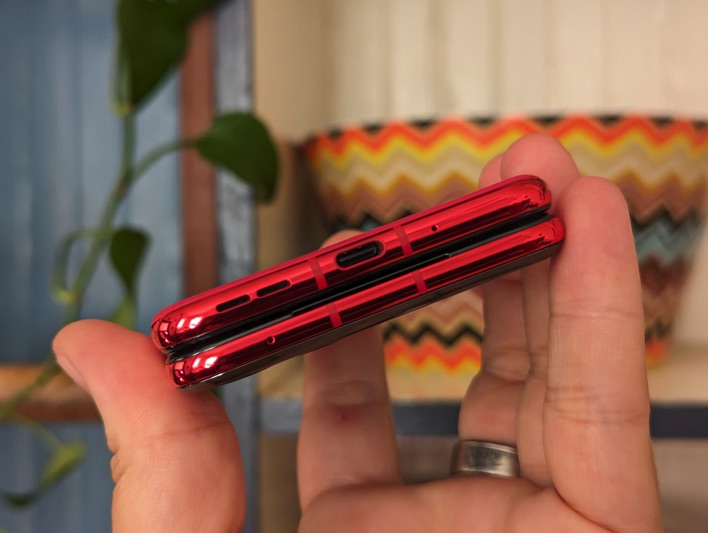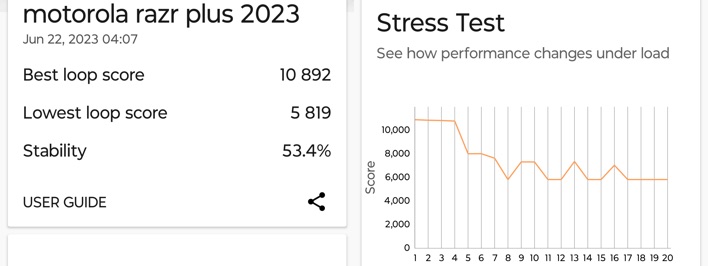Motorola Razr+ (2023) Review: The Folding Flip Phone, Reinvented
Moto Razr+ (2023) Review: Audio Quality, Performance, And Battery Life
Moto Razr+ (2023) Audio, Data, and Call Reception
We tested the Moto Razr+ (2023) primarily on T-Mobile and Telus’
sub-6GHz 5G and 4G LTE networks in San Francisco and Vancouver (Canada)
and didn’t experience any problems with call quality of data speeds. This
phone lacks mmWave 5G, but supports dual SIMs (nano SIM + eSIM), and works
on all major US carriers. It’s available unlocked but also from T-Mobile
and AT&T (sorry Verizon customers).
When it comes to audio performance, the Razr+ delivers. It packs stereo speakers (bottom edge plus earpiece) with Dolby Atmos that sound incredibly good considering the form factor. As you’d expect, this handset lacks a headphone jack, but it supports digital audio devices over USB Type-C for wired listening with your favorite DAC / amp, plus LDAC and aptX HD for high-quality wireless sound over Bluetooth.
When it comes to audio performance, the Razr+ delivers. It packs stereo speakers (bottom edge plus earpiece) with Dolby Atmos that sound incredibly good considering the form factor. As you’d expect, this handset lacks a headphone jack, but it supports digital audio devices over USB Type-C for wired listening with your favorite DAC / amp, plus LDAC and aptX HD for high-quality wireless sound over Bluetooth.
Moto Razr+ (2023) Performance
The Moto Razr+ (2023) combines Qualcomm’s high-end Snapdragon 8+ Gen 1
SoC with 8GB of RAM and 256GB of UFS 3.1 storage. Obviously, this phone
feels pretty quick and responsive no matter how many apps you’re juggling.
Our standard collection of social media, communication, and entertainment
apps ran without skipping a beat, and the high refresh rate kept
everything silky smooth on both displays.
As you can see from our benchmarks (below) the Razr+ doesn't compete with today's latest flagships, but it's plenty fast, with performance generally on par with other Snapdragon 8+ Gen 1-equipped handsets. Sustained workloads – like serious gaming – are a major challenge, though. As with most other folding flip phones we’ve tested, the Razr+ exhibits significant thermal throttling, dropping to 53.4% after 20 minutes in 3DMark’s Wild Life stress test.
While this is unfortunate, hard-core gamers aren’t the target audience for this product, so we don’t expect most Razr+ users to experience any performance issues with typical day-to-day apps.
As you can see from our benchmarks (below) the Razr+ doesn't compete with today's latest flagships, but it's plenty fast, with performance generally on par with other Snapdragon 8+ Gen 1-equipped handsets. Sustained workloads – like serious gaming – are a major challenge, though. As with most other folding flip phones we’ve tested, the Razr+ exhibits significant thermal throttling, dropping to 53.4% after 20 minutes in 3DMark’s Wild Life stress test.
While this is unfortunate, hard-core gamers aren’t the target audience for this product, so we don’t expect most Razr+ users to experience any performance issues with typical day-to-day apps.
Moto Razr+ (2023) Geekbench Results
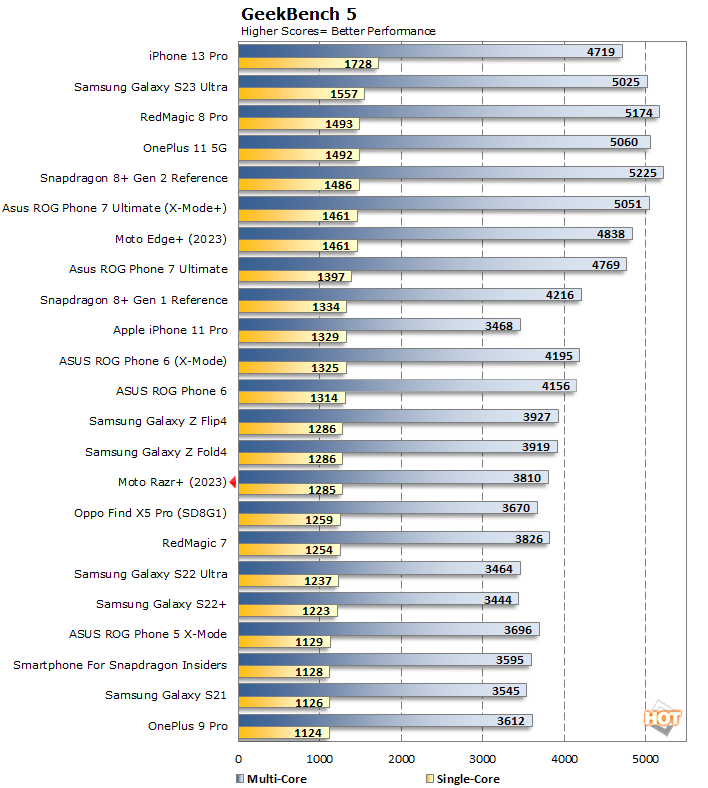
GeekBench is a purely synthetic benchmark and can be heavily targeted
for optimization. Regardless, the Snapdragon 8+ Gen 1 processor delivers a
notable improvement in single and multi-threaded performance over previous
generation Snapdragon
8
Gen 1-equipped Android flagships.
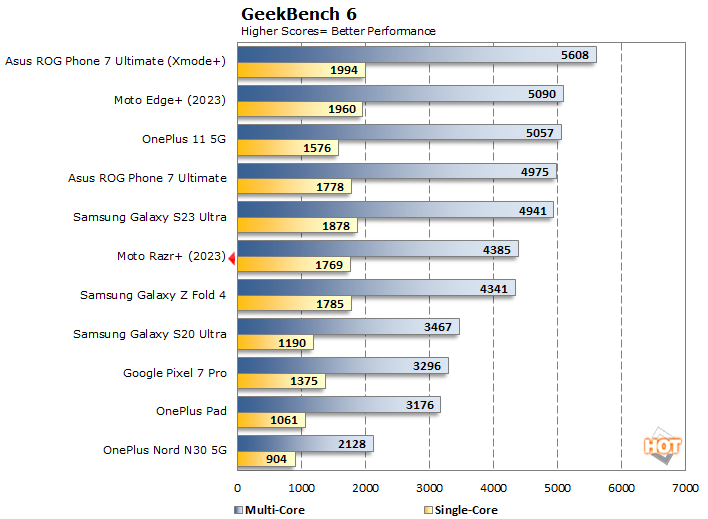
Recently, Geekbench was upgraded to version 6, which includes new ways
of testing multicore configurations and uses higher-resolution assets.
Since this benchmark is brand new, we don't have as many data points, but
as you can see, the Moto Razr+ (2023) performed quite well in this test.
Moto Razr+ (2023) PCMark For Android Benchmarks
Futuremark's PCMark for Android is an excellent suite of tests if you
want to benchmark a wide range of tasks on any handset -- things like
image and video editing, as well as lighter-duty, everyday workloads such
as email and web browsing. When you see the test running live, it's clear
the scripted application tests are carefully selected and tuned to make
use of the each mobile platform in a very controlled way...
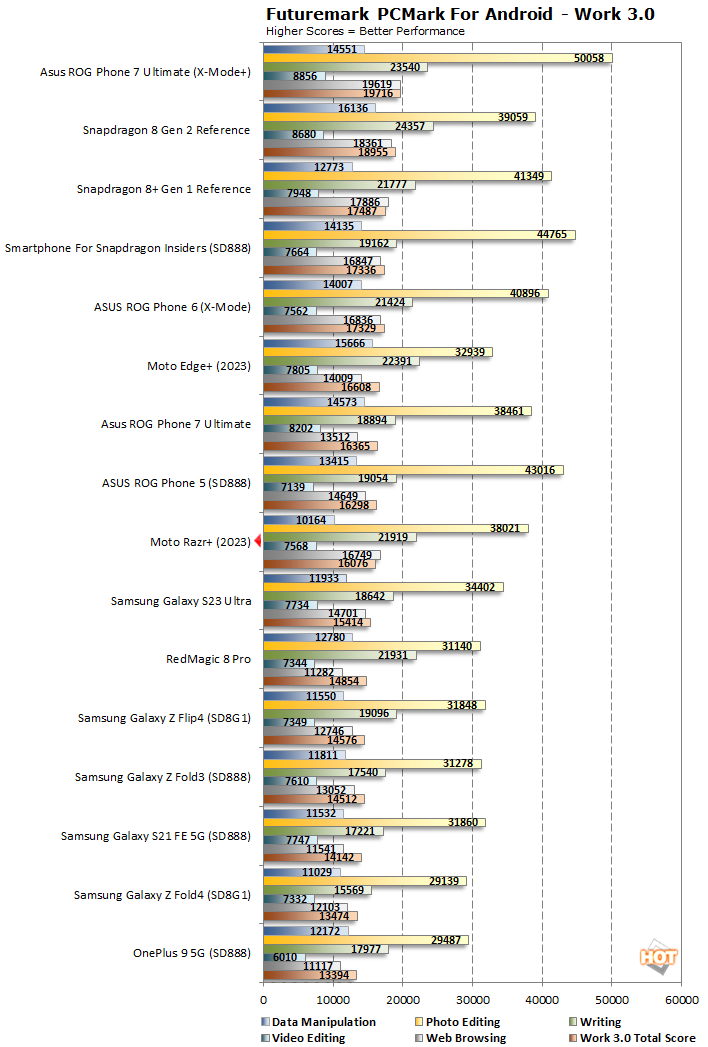
Here the Moto Razr+ (2023) shows similar performance to current Snapdragon 8 Gen 2-equipped devices, slotting just above Samsung's Galaxy S23 Ultra.
Moto Razr+ (2023) AnTuTu 8 Benchmark Results
AnTuTu’s latest benchmark returns a number of metrics ranked with
somewhat nebulous scores, rather than frame rates or time to complete.
Here we're running the latest version of AnTuTu across multiple Android
devices. AnTuTu returns four top level performance results which are all
included here: CPU, RAM, 3D, UX (or User Experience), along with a total
score...
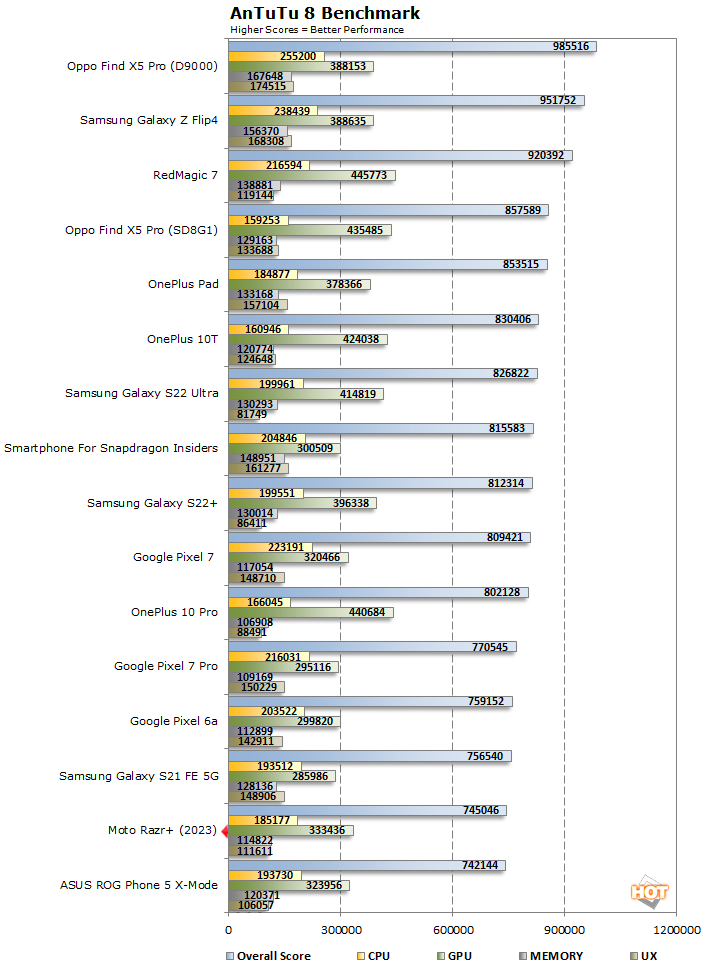
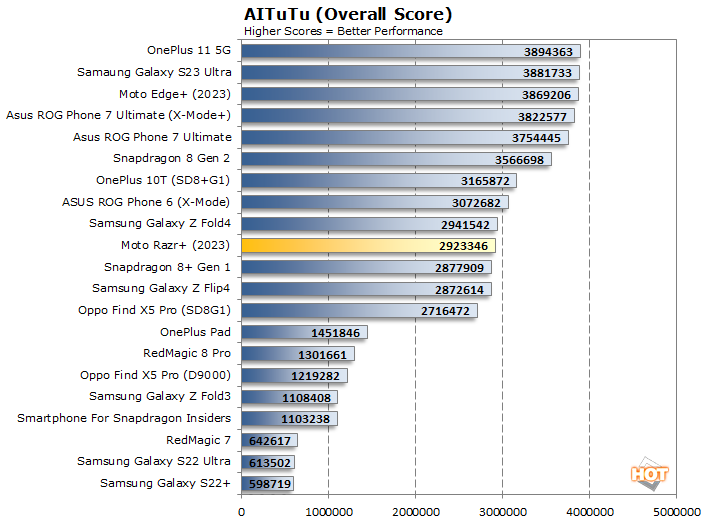
According to AnTuTu, the Moto Razr+ (2023) under-performed vs. current generation Android handsets, which was unexpected.
However, in AITuTu, which is specifically an image recognition and classification benchmark for AI and machine learning workloads, we see a different picture. Here there are big gains for Snapdragon 8+ Gen 1 powered devices like the Moto Razr+ (2023), putting it right alongside the Samsung's Galaxy Z Flip4.
However, in AITuTu, which is specifically an image recognition and classification benchmark for AI and machine learning workloads, we see a different picture. Here there are big gains for Snapdragon 8+ Gen 1 powered devices like the Moto Razr+ (2023), putting it right alongside the Samsung's Galaxy Z Flip4.
3D Graphics And Gaming Benchmarks With The Moto Razr+ (2023)
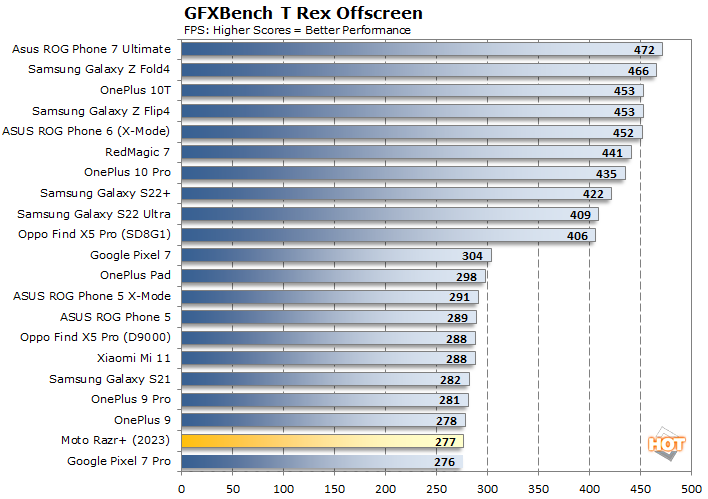
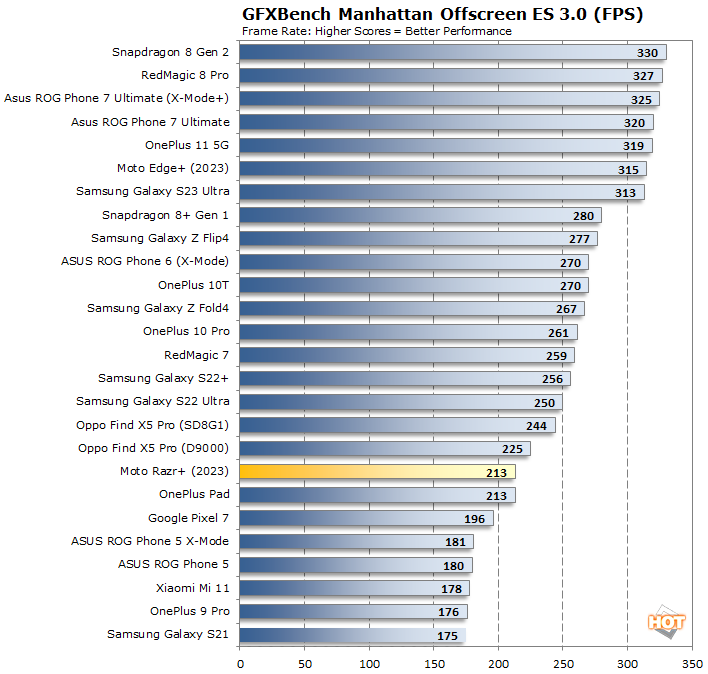

Based on other Snapdragon 8+ Gen 1-equipped devices we've reviewed, the Moto Razr+ (2023) under-performed in these tests, which was surprising, but Moto is probably being conservative with the VFC to keep the device cool and maximize battery life.
Futuremark's 3DMark Sling Shot is a newer benchmark module that's been added to the 3DMark mobile suite. Unlike previous gen 3DMark mobile tests, Sling Shot is a much more advanced OpenGL ES 3.1 and Metal API-based benchmark that employs more advanced rendering techniques, like volumetric lighting, particle illumination, multiple render targets, instanced rendering, uniform buffers and transform feedback.
Futuremark's 3DMark Sling Shot is a newer benchmark module that's been added to the 3DMark mobile suite. Unlike previous gen 3DMark mobile tests, Sling Shot is a much more advanced OpenGL ES 3.1 and Metal API-based benchmark that employs more advanced rendering techniques, like volumetric lighting, particle illumination, multiple render targets, instanced rendering, uniform buffers and transform feedback.

3DMark Sling Shot Extreme Benchmark
We're running this test in off-screen mode once again to remove
display resolution differences from the equation. This lets us compare
cross-platform results more reliably...
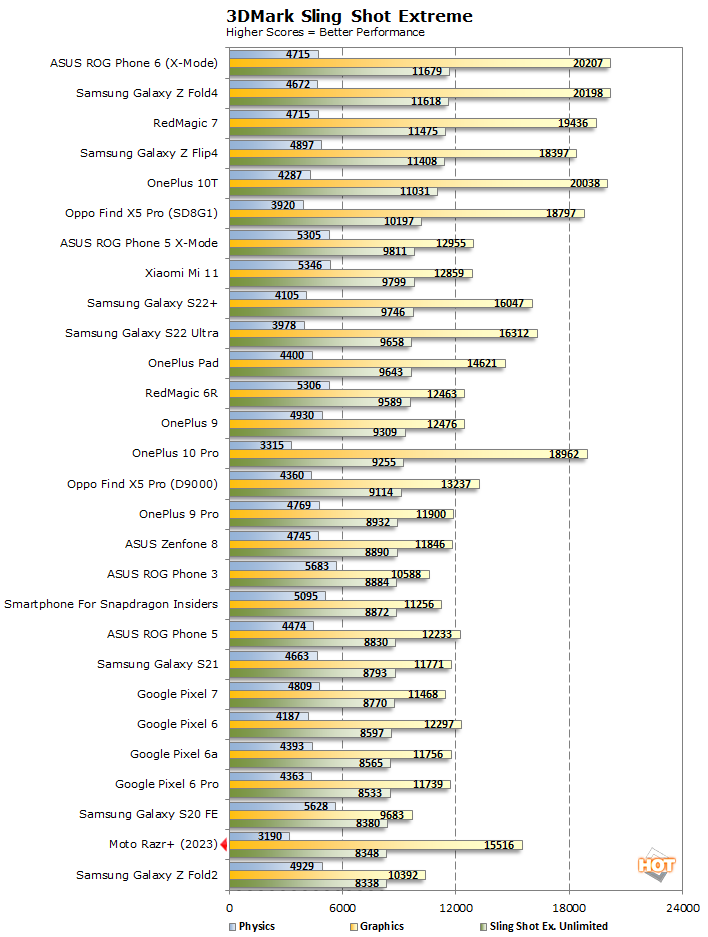
Here again, the Moto Razr+ (2023)
under-performed in this test, showing decent graphics performance but poor physics performance. The CPU cores are underperforming here for an unknown reason.
Moto Razr+ (2023) 3DMark Wild Life Benchmark Tests
3DMark Wild Life is the latest cross-platform test from UL. Its
primary purpose is to measure GPU performance across platforms, and two
distinct tests are available. The standard Wild Life test is designed to
give feedback on how a game performs over a short period of time. With
mobile games, people typically play in brief spurts when they find some
free time; be it on the bus, on the subway, or a quick battle royale
session over lunch break. The 3DMark Wild Life Stress Test, on the other
hand, shows how a device performs over a longer stretch of time, and
takes note of performance degradation that might crop up due to
increased heat levels and throttling.

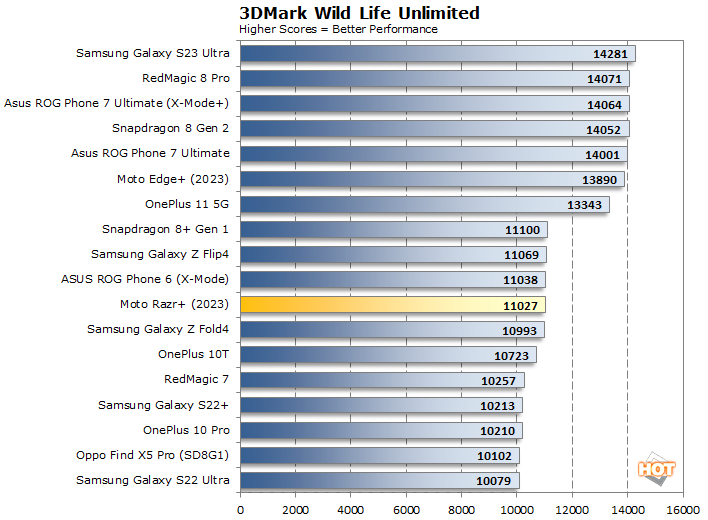
3DMark Wild Life is a significantly more taxing graphics benchmark
that employs cutting-edge mobile game engine technologies to deliver
impressive visuals -- as you can see in the screen shot above.
Here the
Snapdragon 8+ Gen 1-powered Moto Razr+ (2023) matches similar devices, like Samsung's Galaxy Z Flip4.
Unfortunately, the Moto Razr+ (2023) does exhibit similar throttling to
what we experienced with other folding flip phones, managing a stability
score of 53.4% in the Wild Life Stress test.
Moto Razr+ (2023) Other Features and Battery Life
Other specs are quite familiar, and include sub-6GHz 5G, CAT 22 LTE,
tri-band WiFi 6e (802.11ax), Bluetooth 5.3 (LE), NFC, A-GPS / LTEPP / SUPL
/ GLONASS / GALILEO positioning, plus the usual array of sensors. The
side-mounted capacitive fingerprint reader is fast and accurate, but face
unlock is hit and miss. A linear vibration motor provides superb haptics,
if slightly weaker than expected.

When it’s time for a refill, the Razr+ supports 30W wired charging (USB PD) and 5W Qi-compatible wireless charging (which is pretty slow). Unfortunately, there’s no charging brick supplied in the box, and no reverse wireless charging.
Next up: the software, pricing, and the review verdict...

